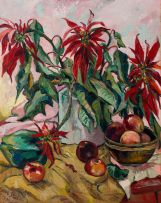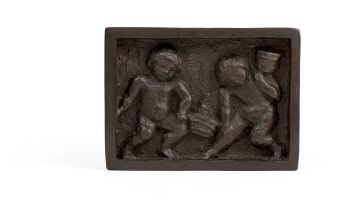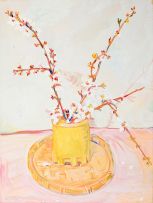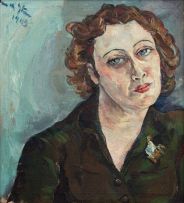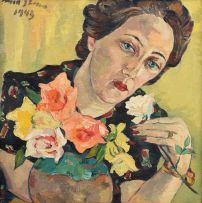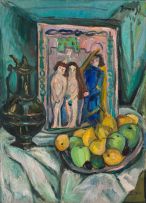Important South African and International Art
Live Auction, 13 November 2017
Session Three
Incl. Buyer's Premium & VAT
About this Item
signed and dated 1934
Notes
Flower paintings form a significant part of Stern's oeuvre, a theme to which she returned again and again throughout her career. In effect, they constitute something of a bridge between the other two key subjects that preoccupied her - portraits of those in her social milieu (of which the portraits of Freda Feldman on this sale are a key example), and paintings of 'exotic' others; Africans, Arabs, and Malays that she encountered both on her travels and at home. Like the social portraits, the flower paintings are intimate, and often give us insights into her private and personal preoccupations. Like the 'exotic' portraits, they are lush and sensual, vehicles for her unbounded creativity, sensuality, and love of colour and beauty. But most tellingly, perhaps, they are symbolic portraits of her personal world, a vivid recreation of the myriad artefacts and objets with which she surrounded herself, and which gave her pleasure.
Various writers have commented on the extent to which Stern's portraits - whether of graceful and accomplished society women like Freda Feldman, or beautifully sensual 'others' - were a means of sublimating her own lack of self-esteem in relation to her appearance. Her overweight figure, plain appearance and overbearing personality were in marked contrast to the beauty and sensuality of her paintings, and despite being a prolific and skilled portraitist, she never painted a self-portrait. As Esmé Berman put it, "she surrounded herself with things that gave her pleasure, and sublimated her blighted hopes and dreams by transforming her pleasurable perceptions into art".1 The flower paintings, of which Poinsettias is a fine example, play directly into this aspect of Stern's oeuvre. As such, they occupy an important position not only as dazzlingly beautiful objects that continue to delight us, but also as a reminder of the extent to which art allows us the extraordinary intimacy and poignancy of seeing the world through the eyes of another.
While Stern did not restrict herself regarding the choice of flora for her paintings, she returned again and again to certain favoured varieties. These included poinsettias, whose striking scarlet bracts lent themselves well both to her love of the colourful and the exotic. As with most of her flower paintings, the poinsettias are not depicted in isolation, but are accompanied by various domestic items in addition to the vase in which they are placed: a bowl of red apples, fabrics, the edge of a table. In this instance, these items serve formally to balance the composition, while at the same time setting up a sumptuous play of colour. The bright red of the flowers is picked up and intensified in the apples and the hint of the table top that is visible in the bottom right-hand corner. These reds are in turn offset againt the poinsettia's leaves and a bright viridian quince. The strident complementarity of these colours is further intensified by a background of bright pink, with smears of pale green. This is a characteristically audacious use of colour, and in keeping with Stern's impatience with colours that 'matched'.
Indeed, this painting is a remarkable example of Stern's brilliant sense of colour, and her ability to explore a vibrant and even riotous palette while remaining true to a single colour theme - in this case, the dominant red - accented by contrasting hues. Although they resemble each other in composition and subject, her flower paintings are never formulaic. Each is a resplendent and vital celebration of life and creativity, defying the lugubrious symbolism of the memento mori conventionally associated with the genre.
Painted in 1934, this painting is of particular historical significance in Stern's oeuvre, as it was exhibited at the Empire Exhibition in Johannesburg in 1936, along with Malay Bride and Orange Harvest.2 The Empire Exhibition marked a turning point in Stern's career, bringing her both wider exposure to the South African public, and a shift away from the negative reviews that had marked her earlier exhibitions. It was also as a direct consequence of the Empire Exhibition that the South African government began acquiring Stern's work for its legations overseas, marking her out as an artist of significance, and putting in place the foundations of the canonical stature that posterity has bestowed on her.
Federico Freschi
1 Esmé Berman, personal communication, 27 October 2013.
2 Ibid.
Provenance
Barloworld Collection
Exhibited
The Empire Exhibition, Johannesburg, 15 September 1936 - 15 January 1937.
Literature
Marion Arnold (1995). Irma Stern: A Feast for the Eye, Vlaeberg: Fernwood Press. Illustrated in colour on page 33.

